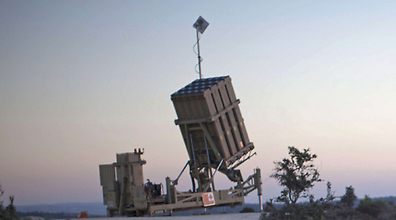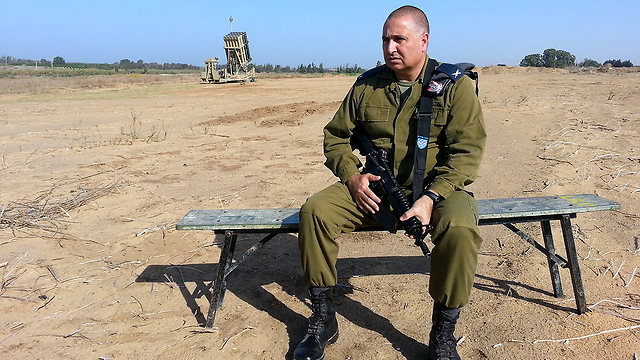
'Iron Dome soldiers deserve proper credit for role in country's defense'
'Soldiers of the Air Force Defense Command are combat soldiers, exclamation point," Active Protection System commanding officer Col. Arik Haimovich says. Israel, meanwhile, not resting on its laurels from past successes, is upgrading defense systems and preparing for multiple front counter-attacks
Brig. Gen. Shachar Shohat, the commanding officer of the Air Force Defense Command, is even considering taking things one step foward by giving the soldiers a citation of honor and working to secure their status as combat soldiers.
Related stories:
- Iran unveils drone which can reach Israel
- Report: Fewer rockets on Israeli soil since operation Pillar of Defense
- 5 soldiers injured in Gaza border incident
Speaking from one of the units stationed next Ashkelon, Shohat and the executive officer of the Active Protection System, Col. Arik Haimovich, mentioned their latest recommendation to the IDF: Iron Dome soldiers should be classified as combat soldiers.
According to IDF directives, only soldiers who are within the enemy's reach and endanger their lives as part of their service are considered combat soldiers. Shohat and Haimovich, however, have no doubt that for all intents and purposes an Iron Dome soldier is a combat soldier, they say.
"Soldiers of the Air Force Defense Command are combat soldiers, exclamation point," Haimovitch said. "There is no other way to define a role where rockets are falling and where crucial decisions are being made with the highest mental aptitude possible."
Constantly changing battlefront
The unit serves on a farm two minutes from Ashdod, kilometers away from the enemy. "Our battlefield changes right in front of our eyes. Operation Pillar of Defense was devoid of land maneuvers. Because of the threat of rockets, the borders between front and homefront have been blurred. The threat is no longer just the enemy's reach from its border, but the reach of its rockets, as well."

The IDF concept of combat changed completely because of the revolutionary system, the first of its kind in the world. Iron Dome registered an 84% success rate over the 1,500 Gazan rockets fired during Pillar of Defense. It's the main reason why the past year was the quietest year for southern Israel since the Intifada broke out in 2000. With the combination of the Air Force Defense against rockets, precise information from the intelligence units and the Air Force's "threading of the needle" bombings, the scales have been tipped in the battle between Israel and the terror organizations in Gaza.
But Pillar of Defense is over, and Col. Haimovitch wants to remind the public that since the first rocket interception in April 2011, each battle round started just like its predecessor ended – rockets with longer range and more clout.
Preparing for tomorrow
"If the fighting breaks out both in the North and the South, there will be up to hundreds of rockets each day. Tel Aviv will quickly be in the line of fire. We're preparing for a situation of timed rocket fire from both Lebanon and Gaza. We need to understand that Hezbollah learned, and is continuing to learn, how to deal with Iron Dome."
Brig. Gen Shohat said that the threat in the North is rooted in Iran and the anarchy in Syria. "The ammunition is trickling in from Syria, and Lebanon is giving us new threats: Small planes, advanced drones, mid-range rockets and surface-to-surface rockets. Hezbollah has also gained familiarity in how to shoot unconventional rockets." The experienced Patriot missiles will be responsible to intercept the drones.
Even though the Iron Dome systems look the same as they were a couple years ago, there have been through a lot of changes. They have all been upgraded to Block-2 – the newest and most advanced version, which knows how to deal with rocket fire from multiple angles at the same time, and to damage heavy rockets.
Magic Wand, a system designed to intercept rockets, heavy missiles and unmanned aerial vehicles, will begin to operate in about a year. The Arrow, a stationary interception system that can be operated from the center and northern parts of the country, was also upgraded: The new version is portable and deployable.
Still, the Air Force Defense Command can't guarantee hermetic security in the next confrontation. Hezbollah's precise missiles and "suicide" unmanned planes aimed at vital facilities and strategic bases will require crucial decisions to be made, whether to protect a certain city or a strategic facility.
"The discipline of the public will prevent calamities in places where there is no protection," Shohat said.
- Receive Ynetnews updates directly to your desktop












